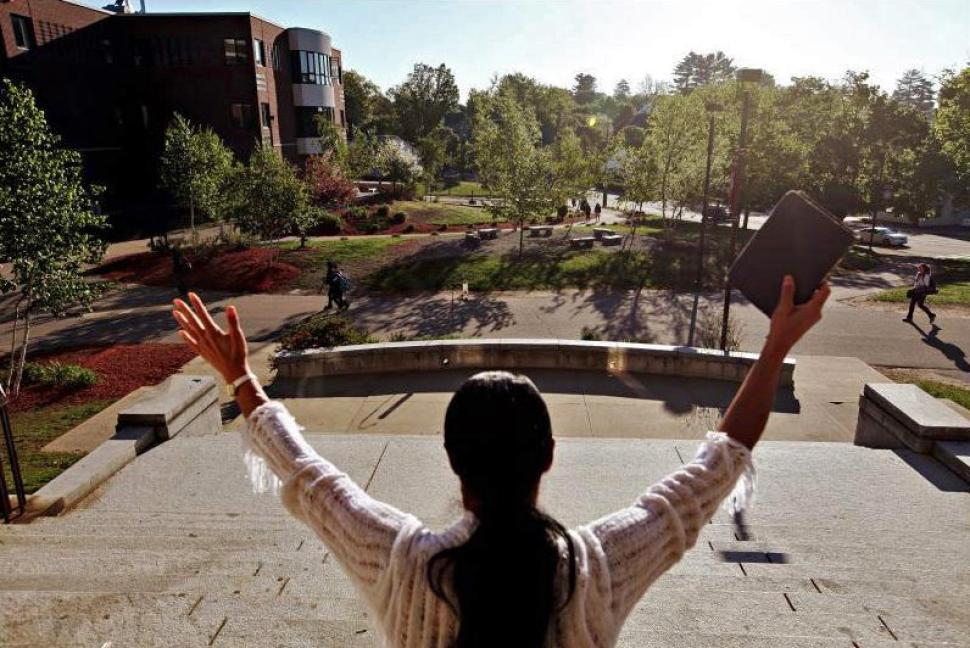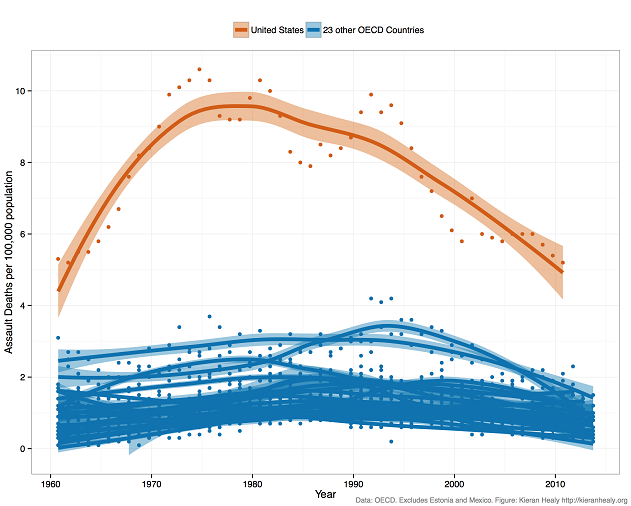On School Shootings and School Prayer

“In matters of religion it is very easy to deceive a man, and very hard to undeceive him.” —Pierre Bayle
Details on the recent massacre in Oregon have barely begun to trickle in, but that hasn’t stopped incurious Christians from connecting mass gun violence to school prayer. This tendency to use national tragedy to bewail the aging Supreme Court decision that banned school-sponsored prayer sees regular rotation, likely because right-wing puppet-masters have yet to locate a negative societal trend they can’t pin it on. Meanwhile, a nation under siege bides its time with thoughts and prayers until our obsession with guns collects its next death toll.
True to form, after every school shooting in this country, some variation of the following lights its way across social media like flame to paper.
Number of times this meme has been shared?
A: 900,000 and climbing
Number of people who exercised the slightest bit of skepticism before sharing it?
A: 0
And given that there have been no fewer than 76 school shootings since this meme was first uploaded (and hundreds of shootings independent of venue), it’s safe to say this one’s soaked up heavy bandwidth. After engaging with multiple people who’ve expressed this general sentiment, I decided to craft an organized response for future reference.
No Correlation = No Causation
To start, we can examine the underlying data and the relevant history to gain a sharper picture of the facts on the ground. Let’s start with the data. The person who created the meme may not have been paying attention, but in fact the US has had at least one school shooting every 1-2 years going back to at least the 1910s. Some years had more than others, but the numbers are pretty consistent leading up to present day.
We can also zoom out and look at the overall incidence of assault deaths in this country following the 1962 court decision. When isolating assault crime and its change over time, we find the per capita death rate has actually seen a steady decline in the US since the 1970s — though we remain ever the outlier relative to the developed world as a whole.
The FBI’s UCS Annual Crime Reports concur, with murder rates per capita in decline since the 1960s. Their data show 19,684 persons per murder in 1960 compared with 22,378 persons per murder in 2014, or 5.1 murders per 100,000 in 1960 compared with 4.5 per 100,000 as of 2014. The Bureau of Justice Statistics has further corroborated the per capita drop in violent crime since the 1970s.
If we really want to play fast-and-loose with causation, we could turn the logic of the meme on its face and conclude that it was the removal of state-sanctioned prayer in schools that has led to the decline in assault death rates. Of course, as you learn in introductory statistics courses, correlation without evidence of causation does not a logical argument make; a spate of other variables has likely played a role in these figures.
It is also important to keep in mind that regional death rates often differ, sometimes demonstrably, from national death rates. For example, states with stricter gun control laws have fewer deaths from gun-related violence. Of the various studies that have been conducted, it wasn’t higher populations, more stress, more immigrants or more mental illness that correlated with gun violence; it was gun control legislation that had the largest effect on the data.
Regionally speaking, southern states have far and away the highest incidence of assault deaths. And as it turns out, those states are generally the softest on gun control. (They also happen to be quite big on prayer, but we’ll ignore that for now.) Once again, correlation does not equal causation, but the preponderance of studies to date suggest that access to guns is a strong contender for explaining these and other similar disparities.
Evangelicals who uncritically imbibe memes like the one above also have a difficult time explaining the many awkward counterexamples that put the lie to their reductive narrative. Take Japan, a country that is as close to America’s antonym in terms of the distribution of religious belief as you could possibly imagine, where only ~30% identify as belonging to a religion of any kind and fewer than 1% identify as Christian. There is no school prayer in Japan, yet they have one of the lowest crime rates of any developed nation [1][2][3]. The yarn really begins to unravel when you look at Scandinavia, where religiosity is nearly nonexistent: Norway, Denmark, Finland, Sweden and Iceland all have about as much crime and as many mass shootings as they have religion.
Pledge of Allegiance
The meme also mentions the national pledge, so let’s get the facts straight here as well. There are six, and only six as of this writing, states that do not have mandatory recitation of the Pledge of Allegiance during the public school day: Hawaii, Iowa, Nebraska, Oregon, Vermont, and Wyoming. In all other states, time is set aside for the pledge to be recited by students on a voluntary basis. Students may opt to recite the passage in full, stay silent during the recitation, or stay selectively silent (as in omitting the “under God” language of the pledge).
While we’re on the topic, the phrase “under God” did not appear in Francis Bellamy’s original poem from 1892. Nor was it included in the revised pledge adopted by Congress in 1942. In fact, this phrase did not show up until 1954, when President Eisenhower pushed it through Congress as part of National Flag Day. Far from dating back to the time of the founders, the staple slogan “one nation under God” — an antisecular oath if there ever was one — is a relatively recent adaptation of Christian nationalist rhetoric.
As it stands, the vast majority of parents in this country can rest easy knowing that their child has every opportunity to show off their patriotism at morning assembly.
The Constitutionality of Prayer
Finally, we as a nation didn’t “get rid” of prayer. One cannot restore something that was never taken away in the first place. Petitioning to bring prayer back in schools is like petitioning to bring diesel cars back on the road. Just as a step-up in regulations for diesel fuel did not prohibit the sale of diesel-propelled vehicles, kids, teachers and, indeed, any believing individual can still pray in school. What the 1962 ruling (Engel v. Vitale) deemed unconstitutional was coercive — or teacher-led — prayer.
School-sponsored prayer stands in clear violation of the Establishment Clause of the First Amendment because it forces students — who may observe any number of religions, or none at all — to participate in the rituals of a specific religion. The state, which in this case applies to the staff of the school, can neither promote nor inhibit religious expression. (An exception is made for the latter when students make use of school resources to engage in religiously oriented activities.) That means an instructor who demands a student stop praying is just as constitutionally in the wrong as one who dragoons students into doing so. Whether your child happens to attend private or public school, they are still free to pray on their own and organize faith-based groups on their own time.
Purely from a practical standpoint, we can see how doing away with these protections would create situations in which individual states and schools privilege one religion, denomination or creed above all others. Perhaps at the behest of the school administrator, special classes based around the regionally or demographically dominant faith are inserted into the curriculum: daily teachings on Mormonism become the norm in Utah; tests and exams begin to reward knowledge of the practices of Jehovah’s Witnesses. This is not a workable system in an environment designed to be a place of learning. Because public schools house many cultures and many religions, official activities that serve the purpose of one religion at the expense of all others are necessarily exclusionary.
Parents who wish for a daily emphasis of their particular religion are free to enroll their child in private schools that affirm their precise set of beliefs. What they should not do, however, is presume that every other student shares the same religious commitments they teach at home. So unless those same parents are willing to have their child be led in observing Salāt five times a day or directing the morning prayer to Vishnu, they should accept that a secular framework admits of the least friction in a culturally diverse society.
America’s founders recognized that it is the school’s responsibility to educate, the parent’s to teach morals, and the pastor’s to teach scripture. The school is not a place of worship, and it is not the government’s place to catechize. Many Christians, Jews, and non-fundamentalists the world over understand that morals, behavior and religious praxis are family-constructed issues. If you teach your child that prayer is an important part of individual and spiritual growth, they may choose to do so on their own. Yes, even at school, which, once more for those in the back, students have always had the right to do.
Further reading:
- School Prayer and Pledge of Allegiance: Types of Prayer Banned
- The Man Who Wrote the Pledge of Allegiance
- How the Pledge of Allegiance Went From PR Gimmick to Patriotic Vow
- How ‘One Nation’ Didn’t Become ‘Under God’ Until The ’50s Religious Revival
- Jefferson’s Letter to the Danbury Baptists
Feature image credit: John Tully/Concord Monitor




Comments